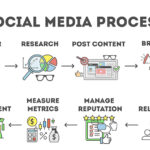
When you start a business, creating a social media profile is one of the best ways to ensure your presence. Social media is an excellent way for businesses to interact with their customers. Sometimes companies stretch too far, creating too many profiles than are needed for their business. Not every social media platform is right for every business, but which ones are right for yours?
Choosing the right social media platform is crucial for a business’s success. Posting on the wrong social media platforms can waste time because you’re not reaching out to your target audience and not all types of posts are successful across platforms.
While some businesses have mastered being on almost every platform, not all businesses have the manpower or funding to maintain a social media presence on every platform. There are apps to streamline posts and communication, but are they worth it? Is it worth posting on Pinterest and TikTok? Let’s find out.
Strengths of Popular Social Media Platforms
When deciding which social media platforms are correct for your business, you must analyze the strengths and weaknesses of each platform.
Facebook has been around for a long time, and going from a target audience of only college students to anyone with an email, you have a wide audience range to access with such a diverse user base.
Facebook is effective for branding and makes it very easy to engage with customers. There are many options to respond to comments and messages, and you can follow many tactics to get your content shared quickly.
Facebook also offers paid advertising towards targeted campaigns.
Facebook also allows you to provide your business information, including hours of operation and contact information.
Intagram is a visually focused platform. You can only post photos or videos with descriptions on this platform. It is ideal for showcasing products and services for your customers and potential customers.
Instagram has a strong influence on younger demographics, especially those under 40.
Twitter/X
Using Twitter/X has always been an effective form of quick mass communication. This platform is a go-to for many organizations for real-time communication and news sharing. It’s excellent for customer service and crisis management.
LinkedIn is a professional social networking platform ideal for B2B marketing and recruiting. Successful pages tend to belong to individuals rather than businesses; however, businesses are more likely to use LinkedIn to share updates and show they are recruiting.
TikTok
TikTok hit social media quickly and gained popularity by engaging younger audiences and making it simple to build brand awareness. Posts are only made in short-form videos, and humor and suspense tend to do the best.
Many influencers start with TikTok to build brand awareness for their products, which offers a great way to monetize your content.
| Platform | Audience Demographics | Best Content Type | General Focus |
| Diverse, 18–65+ | Posts, Ads, Videos | Broad audience, reputation focus | |
| Professionals, 25–55 | Blogs, Articles | B2B engagement, recruiting | |
| Visual-first, under 40 | Photos, Stories | Brand-building, younger clients | |
| Twitter/X | Professionals, News-focused 18–45 | Real-time updates, News, Quick Tips | Customer service, thought leadership, crisis communication |
| TikTok | Younger audiences, Gen Z & Millennials, 13–35 | Short-form videos, Humor, Trends | Brand awareness, engaging younger audiences, showcasing creativity |
Understanding Your Target Audience
Now that we know the major social media platforms to get your business on, you should analyze and understand your target audience. Once you know your target audience, demographics, and psychographics, you can determine the social media platforms that are appropriate for them.
Stuck on which platforms to post on? Reach out to Bizbotweb today for some guidance!
Choosing the Right Platforms for Your Business
After understanding your target audience, there are more things to consider before deciding which social media platforms you will be posting on. The things to consider are:
- Your business goals: are you there to entertain, educate, or sell?
- A budget and resources: how much money are you willing to spend on social media posts, advertising, content creation, and management?
- Content calendars: creating a content calendar to know what will be posted and when is the best way to provide consistency to your followers
Best Practices for Social Media Marketing
After going through and deciding which social media platforms are right for your business, there are some best practices you should follow to ensure that your content is top-notch and your social media efforts aren’t ignored:
- Develop a strong brand voice and visual identity
- Create high-quality, engaging content
- Utilize relevant hashtags and keywords
- Monitor social media analytics
- Respond to comments and messages promptly
Integrating Social Media into a Broader Marketing Strategy
Social media is a powerful tool, but its true potential is unlocked when integrated into a broader digital marketing strategy. While posting engaging content and building a follower base is important, the key to sustained growth lies in aligning social media efforts with other marketing channels. By connecting social media with tools like email marketing, SEO, and CRM systems, businesses can create a seamless customer journey that drives measurable results.
For example, imagine a law firm that uses LinkedIn to publish thought leadership content. By linking those posts to a blog optimized for search engines, the firm can attract website traffic while nurturing leads captured through a CRM. Simultaneously, retargeting these website visitors with Facebook ads can help convert them into clients.
This integrated approach ensures no platform works in isolation, increasing efficiency and delivering consistent messaging across channels. Additionally, using automation tools like Hootsuite or integrating CRM systems like HubSpot or Go High Level makes managing these efforts scalable and less time-consuming.
Incorporating social media into a broader strategy amplifies its impact, making it a cornerstone of your business’s digital marketing success.
Conclusion
Choosing the right social media platforms for your business is not a decision to be made lightly. It requires careful consideration of your target audience, business goals, and available resources. Taking a strategic approach ensures that your social media efforts are not wasted on the wrong platforms or ineffective content. However, social media works best when it’s integrated into a broader marketing strategy.
By combining social media with tools like email marketing, SEO, and CRM systems, businesses can create a seamless and effective customer journey. This holistic approach amplifies results, turning engagement into measurable growth.
Experimenting with different platforms and strategies is key, but don’t forget to monitor analytics and adapt to changing trends. By taking this integrated and adaptive approach, your business can not only stay relevant but thrive in the ever-evolving digital landscape.

Since its launch in 2016, Bizbotweb has been at the forefront of empowering businesses and individuals to easily navigate the digital world, from owning their intellectual property to managing websites and simplifying WordPress setups. As the author of our articles, the “Chief Robot” brings a wealth of knowledge and innovation, embodying Bizbotweb’s commitment to making digital presence seamless and accessible for everyone. Focusing on integrated digital marketing efforts, our content is designed to guide users through the evolving digital landscape, ensuring they have the tools and insights needed to thrive online.
Blog Categories
Check out other Pages
Have questions?
Schedule a free consultation if you have questions about our digital marketing services or would like additional information.










